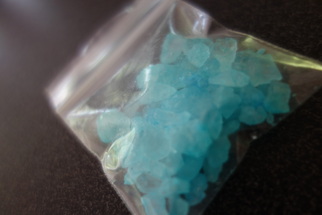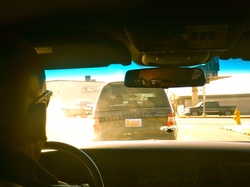
There was a suspicious abundance of blue crystals in baggies, and even more in bulk.
It looks like the handiwork of meth cook extraordinaire Walter White from Breaking Bad, the AMC show that completed its remarkable five-year run in 2013. And with good reason.
I'm at The Candy Lady, a candy shop in Old Town Albuquerque. Proprietor Debbie Ball made the blue meth for the show for the first two seasons. (The prop department took over from there.) Now she sells the stuff to hundreds of fans wander in on a daily basis, along with a wide range of other blue meth-themed souvenirs.
But fear not of getting hooked (although it might still rot your teeth): "It's just rock candy," she says.
Ball says Breaking Bad has done wonders for Albuquerque tourism. "Finally, Albuquerque is on the map," she says. "It is definitely because of the show. People stop rather than drive through."
Business is up, and Breaking Bad-related goods are about a quarter of The Candy Lady's sales. The shop is a must-stop for Breaking Bad fans and the first stop of its limo tour, dubbed The Breaking Bad Experience.
With black hat and sunglasses, Harold Davis, my tour guide and Ball's brother, looks more than a little like Heisenberg, White's villainous alter ego. He was a limo driver who'd shaved his head years earlier who now offers Breaking Bad locations throughout the city.
Does he think it makes Albuquerque look bad? Just the opposite. "There's a lot of Albuquerque flavor written into it," he says. For example, Davis thinks sleazy lawyer Saul Goodman is loosely based on local attorney Ron Bell.
He loves that show creator Vince Gilligan shot at local landmarks and hired local writers. "A lot of my friends would show up as extras," he adds. "I liked seeing all of those local places pop up on national TV."
What's the end result? Did Gilligan's crystal-crusted series capture Albuquerque in the right light? Davis thinks so. "I tell people this is America. This is how it is everywhere."
Maybe not quite everywhere. An apt balance of old and new, civilization and wilderness, and red and green chile makes Albuquerque unique. The city is more than 300 years old, surrounded by 19 active Native American pueblos in New Mexico. The mere thought of the food, a spicy fusion of Mexican and Native American traditions, gets my mouth watering. "Red or green?" is the official state question. (The correct answer: both.)
And now add Breaking Bad tourism to that mix. There's a Breaking Bad package at the Hotel Albuquerque (including blue bath salts in the gift bag). There's a Touring Bad app. And there are tour companies like Harold and Debbie's.
It looks like the handiwork of meth cook extraordinaire Walter White from Breaking Bad, the AMC show that completed its remarkable five-year run in 2013. And with good reason.
I'm at The Candy Lady, a candy shop in Old Town Albuquerque. Proprietor Debbie Ball made the blue meth for the show for the first two seasons. (The prop department took over from there.) Now she sells the stuff to hundreds of fans wander in on a daily basis, along with a wide range of other blue meth-themed souvenirs.
But fear not of getting hooked (although it might still rot your teeth): "It's just rock candy," she says.
Ball says Breaking Bad has done wonders for Albuquerque tourism. "Finally, Albuquerque is on the map," she says. "It is definitely because of the show. People stop rather than drive through."
Business is up, and Breaking Bad-related goods are about a quarter of The Candy Lady's sales. The shop is a must-stop for Breaking Bad fans and the first stop of its limo tour, dubbed The Breaking Bad Experience.
With black hat and sunglasses, Harold Davis, my tour guide and Ball's brother, looks more than a little like Heisenberg, White's villainous alter ego. He was a limo driver who'd shaved his head years earlier who now offers Breaking Bad locations throughout the city.
Does he think it makes Albuquerque look bad? Just the opposite. "There's a lot of Albuquerque flavor written into it," he says. For example, Davis thinks sleazy lawyer Saul Goodman is loosely based on local attorney Ron Bell.
He loves that show creator Vince Gilligan shot at local landmarks and hired local writers. "A lot of my friends would show up as extras," he adds. "I liked seeing all of those local places pop up on national TV."
What's the end result? Did Gilligan's crystal-crusted series capture Albuquerque in the right light? Davis thinks so. "I tell people this is America. This is how it is everywhere."
Maybe not quite everywhere. An apt balance of old and new, civilization and wilderness, and red and green chile makes Albuquerque unique. The city is more than 300 years old, surrounded by 19 active Native American pueblos in New Mexico. The mere thought of the food, a spicy fusion of Mexican and Native American traditions, gets my mouth watering. "Red or green?" is the official state question. (The correct answer: both.)
And now add Breaking Bad tourism to that mix. There's a Breaking Bad package at the Hotel Albuquerque (including blue bath salts in the gift bag). There's a Touring Bad app. And there are tour companies like Harold and Debbie's.

Head to the spot where Walter White caught the van to New Hampshire, or his house, or Los Pollos Hermanos where he met Gus Fring, and you are likely to encounter fans of the show on any given day.
After leaving Old Town, established in 1706, we stop at a couple of Jesse Pinkman's residences. I ask Harold about all of the meth and crime in the show. He doesn't see that as a negative. "I think it would make you want to not do drugs."
We make a quick pass by the Crossroads Motel, where Jesse shacked up with meth-addicted prostitute Wendy. Harold says the proprietors won't let him stop there. "She's kicked me out five times," he says. "I'd be selling T-shirts."
We stop for a photo at the Dog House, the hot dog place that served as a location for several scenes with Jesse, before heading on old Route 66 into downtown.
Next stop: Perched above the city, Albuquerque Studios, the nine-soundstage facility where the crew shot virtually all of the interiors for the show, is actually where you'll end up if you use the GPS coordinates from the show's final episodes.
We stop for some photos at Los Pollos Hermanos -- it's actually a location of the local fast-food burrito joint, Twisters, but it still has some Pol Pollos Hermanos signs up from the show. There's a sign-in book at the counter for fans filled with signatures from people from all over the world.
"These places are generating a lot of business from it," says Davis.
We stop at Octopus Car Wash, which played the part of A1 Car Wash on the show, featuring plenty of memorabilia from the shoots, then head a few blocks over to Walt's house, tucked away in a quiet neighborhood just off of the main drag. There are four fans taking pictures when we arrive.
Harold says the homeowner "came out yelling and screaming” on one of his first tours, "but she came around."
On the day of the finale, a huge crowed was at the house, he adds. "There were 300 people milling around the street with hazmat suits and RVs. I've never seen such rabid fans." And it hasn't let up. "There are people here every day."
Harold credits Vince Gilligan with the cult following. "It's the best show ever written."
After leaving Old Town, established in 1706, we stop at a couple of Jesse Pinkman's residences. I ask Harold about all of the meth and crime in the show. He doesn't see that as a negative. "I think it would make you want to not do drugs."
We make a quick pass by the Crossroads Motel, where Jesse shacked up with meth-addicted prostitute Wendy. Harold says the proprietors won't let him stop there. "She's kicked me out five times," he says. "I'd be selling T-shirts."
We stop for a photo at the Dog House, the hot dog place that served as a location for several scenes with Jesse, before heading on old Route 66 into downtown.
Next stop: Perched above the city, Albuquerque Studios, the nine-soundstage facility where the crew shot virtually all of the interiors for the show, is actually where you'll end up if you use the GPS coordinates from the show's final episodes.
We stop for some photos at Los Pollos Hermanos -- it's actually a location of the local fast-food burrito joint, Twisters, but it still has some Pol Pollos Hermanos signs up from the show. There's a sign-in book at the counter for fans filled with signatures from people from all over the world.
"These places are generating a lot of business from it," says Davis.
We stop at Octopus Car Wash, which played the part of A1 Car Wash on the show, featuring plenty of memorabilia from the shoots, then head a few blocks over to Walt's house, tucked away in a quiet neighborhood just off of the main drag. There are four fans taking pictures when we arrive.
Harold says the homeowner "came out yelling and screaming” on one of his first tours, "but she came around."
On the day of the finale, a huge crowed was at the house, he adds. "There were 300 people milling around the street with hazmat suits and RVs. I've never seen such rabid fans." And it hasn't let up. "There are people here every day."
Harold credits Vince Gilligan with the cult following. "It's the best show ever written."
Eric Peterson / July 2014